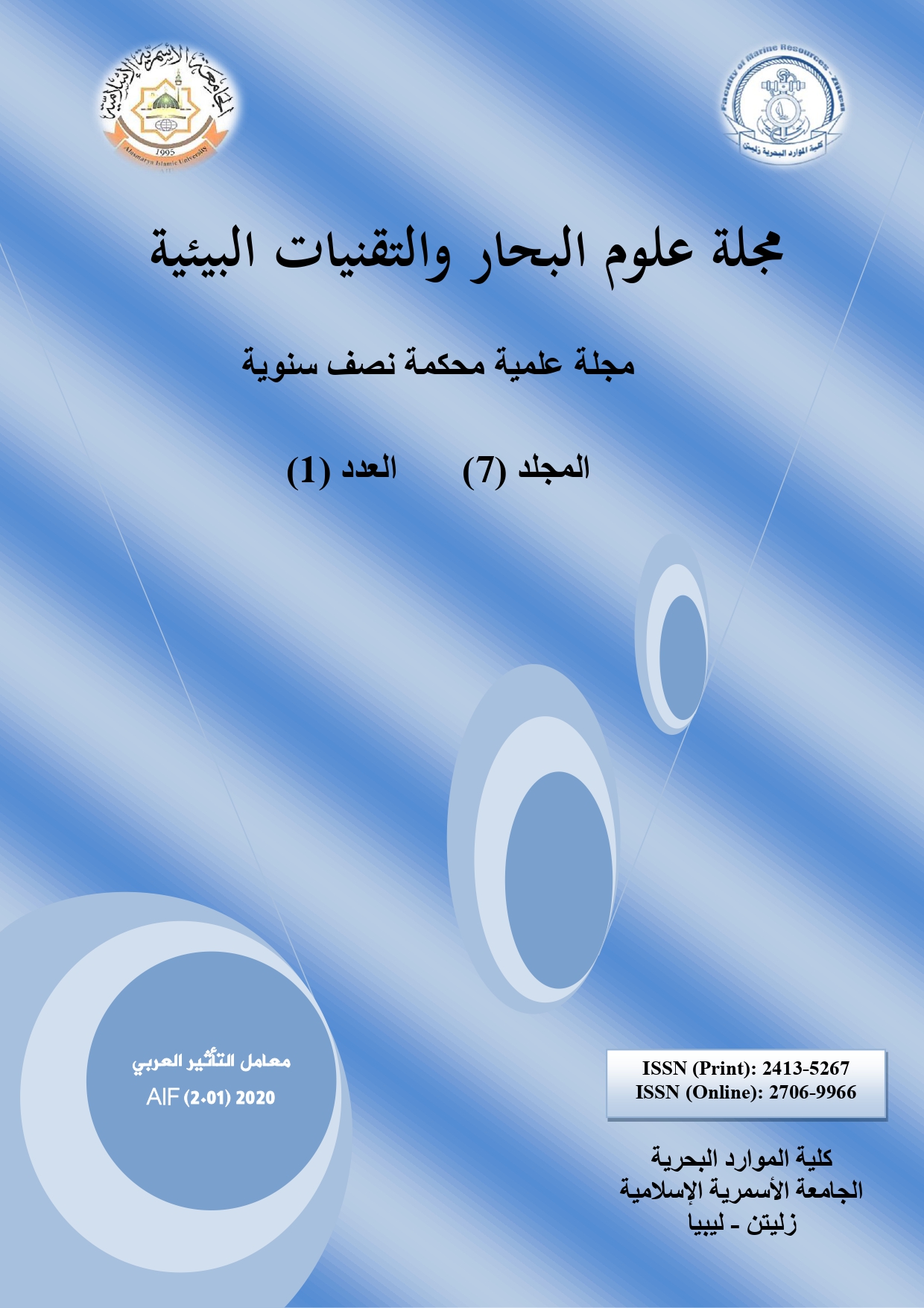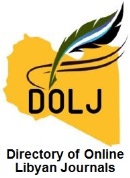هل يؤثر نوع الغذاء في تفضيلات الفريسة لأسماك ثلاثية الاشواك؟
DOI:
https://doi.org/10.59743/jmset.v7i1.26الكلمات المفتاحية:
تفضيلات الفريسة، أسماك ثلاثية الأشواك، تغذية المضيف، السلوكالملخص
تعتبر أسماك ثلاثي الأشواك أنموذج ممتاز من خلاله يتم دراسة أسئلة حول النظم الأيكولوجية للأسماك. فالأسماك ثلاثية الأشواك هي أسماك حيوانية التغذية يمكنها تناول مجموعة واسعة من الأغذية، على الرغم من أن حجمها الصغير نسيبا يحد من قدرتها على اختيار نوعية الغذاء، فتقييم النظام الغذائي وأنماط الغذاء يعطى رؤية مفيدة حول السلوك الغذائي للأسماك. في هذه الدراسة تم استخدام ثلاثة أنواع من مكونات الأغذية الطبيعية لأسماك أبوشوكة لفرضية أن ما إذا كان عدد العوامل بما في ذلك المظهر البصري واللون والملمس والحجم والشكل والقدرة على الحركة يمكن أن يؤثر في سلوك تفضيل الغذاء للأسماك. في هذه الدراسة تم تغذية أسماك أبوشوكة على ثلاثة انواع من الغذاء الطبيعي وهي الأرتيميا والدافنيا ودودة الدم (يرقه حشرات ثنائية الاجنحة) لدراسة سلوك تفضيل الغذاء لأسماك أبوشوكة.
أظهرت النتائج ان هناك فروق معنوية في التفضيل بين أنواع الغذاء، حيث أظهرت الأسماك تفضيل دودة الدم (يرقات الحشرات ثنائية الأجنحة) الأرتيميا بدلاً من الدافنيا وكان هذا الاختلاف في عدد لقيمات الطعام والوقت الذي تقضيه الأسماك بالثواني في منطقة الغذاء وكذلك عدد الزيارات إلى منطقة الغذاء. كما أظهرت نتائج الدراسة أن هنالك بعض العوامل مثل التباين في تركيب الغذاء والحجم واللون والملمس والشكل والرائحة في النظام الغذائي والتي لها تأثير على تفضيلات النظام الغذائي للأسماك.
التنزيلات
المراجع
Allen J. and Wootton R. (1984). Temporal patterns in diet and rate of food consumption of the three‐spined stickleback (Gasterosteus aculeatus L.) in Llyn Frongoch, an upland Welsh lake. Freshwater Biology, 14(4): 335-346.
Andrian I. (1996). Espectro alimentar e variaçoes sazonal e espacial da composiçao da dieta de Parauchenipterus galeatus Linaeus, 1766 (Siluriformes, Auchenipteridae) na regiao do reservatório de Itaipu, PR. Rev Bras Biol., 56: 409-422.
Armitage P.D., Pinder L., and Cranston P. (2012). The Chironomidae: biology and ecology of non-biting midges. Springer Science & Business Media.
Azevedo P.D. (1972). Principais peixes das águas interiores de São Paulo, hábitos de vida. POLUIÇÃO E PISCICULTURA, São Paulo: Faculdade de Saúde Pública da USP/Instituto de Pesca, 109-112.
Barber I. (1997). A non-invasive morphometric technique for estimating cestode plerocercoid burden in small freshwater fish. Journal of Fish Biology, 51(3): 654-658.
Barber I. (2013). Sticklebacks as model hosts in ecological and evolutionary parasitology. Trends in Parasitology, 29(11): 556-566.
Barber I. and Huntigford F.A. (1995). The effect of Schistocephalus solidus (Cestoda: Pseudophyllidea) on the foraging and shoaling behaviour of three-spined sticklebacks, Gasterosteus aculeatus. Behaviour, 132(15-16): 1223-1240.
Bogatova I., Shcherbina M., Ovinnikov B., and Tagirova N. (1971). Chemical composition of some planktonic animals under different conditions of growing. Gidrobiologiceski Zurnal, 7(5): 54-57.
El-sayed A.F., El-Ghobashy A., and El-Mezayen M. (2013). Effect of feed color on growth and feed utilization of Nile tilapia (O reochromis niloticus L.) larvae and fingerlings. Aquaculture Nutrition, 19(6): 870-876.
El-Sayed A.F.M. and El-Ghobashy A.E. (2011). Effects of tank color and feed color on growth and feed utilization of thinlip mullet (Liza ramada) larvae. Aquaculture Research, 42(8): 1163-1169.
Falter U. (1987). A functional biology of sticklebacks: RJ Wootton. Functional biology series, Croom Helm, London & Sydney, Elsevier.
German D.P., Nagle B.C., Villeda J.M., Ruiz A.M., Thomson A.W., Contreras Balderas S., and Evans D.H. (2010). Evolution of herbivory in a carnivorous clade of minnows (Teleostei: Cyprinidae): effects on gut size and digestive physiology. Physiological and Biochemical Zoology, 83(1): 1-18.
Gibson M. and Hirst B. (1955). The effect of salinity and temperature on the pre-adult growth of guppies. Copeia, 3: 241-243.
Hahlbeck E., Katsiadaki I., Mayer I., Adolfsson-Erici M., James J., and Bengtsson, B.-E. (2004). The juvenile three-spined stickleback (Gasterosteus aculeatus L.) as a model organism for endocrine disruption II—kidney hypertrophy, vitellogenin and spiggin induction. Aquatic Toxicology, 70(4): 311-326.
Heuschele J., Mannerla M., Gienapp P., and Candolin U. (2009). Environment-dependent use of mate choice cues in sticklebacks. Behavioral Ecology, 20(6): 1223-1227.
Heuts M. (1947). Experimental studies on adaptive evolution in Gasterosteus aculeatus L. Evolution, 89-102.
Hoxmeier R.J.H., Wahl D.H., Hooe M.L., and Pierce C.L. (2004). Growth and survival of larval walleyes in response to prey availability. Transactions of the American Fisheries Society, 133(1): 45-54.
Hynes H. (1950). The food of fresh-water sticklebacks (Gasterosteus aculeatus and Pygosteus pungitius), with a review of methods used in studies of the food of fishes. The Journal of Animal Ecology, 36-58.
Ibrahim A.A. (1988). Diet choice, foraging behaviour and the effect of predators on feeding in the three-spined stickleback (Gasterosteus aculeatus L.). Doctoral Dissertation, University of Glasgow.
Infante A. and Abella S.E. (1985). Inhibition of Daphnia by Oscillatoria in Lake Washington. Limnology and Oceanography, 30(5): 1046-1052.
Jegede T. and Olusola O. (2010). Effects of feed colour on growth and nutrient utilization of Tilapia zillii and Oreochromis niloticus Fingerlings. Agriculture and Biology Journal of North America, 1(6): 1182-1186.
Johannesen A., Dunn A.M., and Morrell L.J. (2012). Olfactory cue use by three-spined sticklebacks foraging in turbid water: prey detection or prey location?. Animal Behaviour, 84(1): 151-158.
Kallayil J.K., Jorgensen T., Engas A., and Ferno A. (2003). Baiting gill nets—how is fish behaviour affected?. Fisheries Research, 61(1-3): 125-133.
Lavens J.D.P. and Sorgeloos P. (1993). Preparation and use of Artemia as food for shrimp and prawn larvae. CRC Handbook of Mariculture: Crustacean Aquaculture.
Maitland P. (1965). The feeding relationships of salmon, trout, minnows, stone loach and three-spined stickle-backs in the River Endrick, Scotland. The Journal of Animal Ecology, 109-133.
Moore J. and Moore I. (1976). The basis of food selection in flounders, Platichthys flesus (L.), in the Severn Estuary. Journal of Fish Biology, 9(2): 139-156.
Nunes B.S., Carvalho F.D., Guilhermino L.M., and Van Stappen G. (2006). Use of the genus Artemia in ecotoxicity testing. Environmental Pollution, 144(2): 453-462.
Pitcher T.J. (1986). Functions of shoaling behaviour in teleosts. The behaviour of teleost fishes. Springer, Boston, MA.
Popham E.J. (1966). An ecological study on the predatory action of the three-spined sticklebacks, Gasterosteus aculeatus. Arch. Hydrobiol., 62: 70-81.
Poulin R. and Fitzgerald G. (1989). Shoaling as an anti-ectoparasite mechanism in juvenile sticklebacks (Gasterosteus spp.). Behavioral Ecology and Sociobiology, 24(4): 251-255.
Shiau S.-Y., and Yu, Y.-P. (1999). Dietary supplementation of chitin and chitosan depresses growth in tilapia, Oreochromis niloticus O. aureus. Aquaculture, 179(1-4): 439-446.
Sun Y., Liu Y., Liu X., and Tang O. (2010). The influence of particle size of dietary prey on food consumption and ecological conversion efficiency of young-of-the-year sand lance, Ammodytes personatus. Deep Sea Research Part II: Topical Studies in Oceanography, 57(11-12): 1001-1005.
Talens-Perales D., Marin-Navarro J., Garrido D., Almansa E., and Polaina J. (2017). Fixation of bioactive compounds to the cuticle of Artemia. Aquaculture, 474: 95-100.
Triantaphyllidis G., Abatzopoulos T., and Sorgeloos P. (1998). Review of the biogeography of the genus Artemia (Crustacea, Anostraca). Journal of Biogeography, 25(2): 213-226.
Villamizar N., Garcia-Alcazar A., and Sanchez-Vazquez F. (2009). Effect of light spectrum and photoperiod on the growth, development and survival of European sea bass (Dicentrarchus labrax) larvae. Aquaculture, 292(1-2): 80-86.
Webster M., Goldsmith J., Ward A., and Hart P. (2007). Habitat-specific chemical cues influence association preferences and shoal cohesion in fish. Behavioral Ecology and Sociobiology, 62(2): 273-280.
Werner E.E. and Hall D.J. (1974). Optimal foraging and the size selection of prey by the bluegill sunfish (Lepomis macrochirus). Ecology, 55(5): 1042-1052.
Wootton R.J. (1976a). Biology of the sticklebacks. Academic Press.
Wootton R.J. (1976b). Biology of the stickleback, Academic Press.
Wootton R.J. (1984a). A Functional Biology of Sticklebacks. Croom Helm, London. Mitochondrial DNA Part B: Resources, 69.
Wootton R.J. (1984b). A functional biology of sticklebacks. University of California Press.
التنزيلات
منشور
إصدار
القسم
الرخصة
الحقوق الفكرية (c) 2021 مجلة علوم البحار والتقنيات البيئية

هذا العمل مرخص بموجب Creative Commons Attribution 4.0 International License.












